Atten Babler Meat FX Indices – Feb ’17
The Atten Babler Commodities Meat Foreign Exchange (FX) Indices were mixed throughout Jan ’17. The USD/Meat Importer FX Index and USD/Domestic Meat Importer FX Index each finished at record high levels throughout the month, however the USD/Meat Exporter FX Index declined from the nine month high experienced during the previous month.
Global Meat Net Trade: Major net meat exporters are led by the U.S., followed by Brazil, the EU-28, India, Canada and Australia (represented in green in the chart below). Major net meat importers are led by Japan, followed by Russia, Mexico, the U.S., China, the EU-28, Hong Kong and Saudi Arabia (represented in red in the chart below).
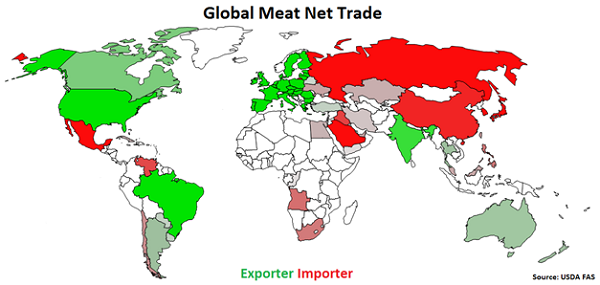 The United States accounts for over a quarter of the USD/Meat Exporter FX Index, followed by Brazil at 22% and the EU-28 at 14%. India, Canada and Australia each account for between 5-10% of the index.
The United States accounts for over a quarter of the USD/Meat Exporter FX Index, followed by Brazil at 22% and the EU-28 at 14%. India, Canada and Australia each account for between 5-10% of the index.
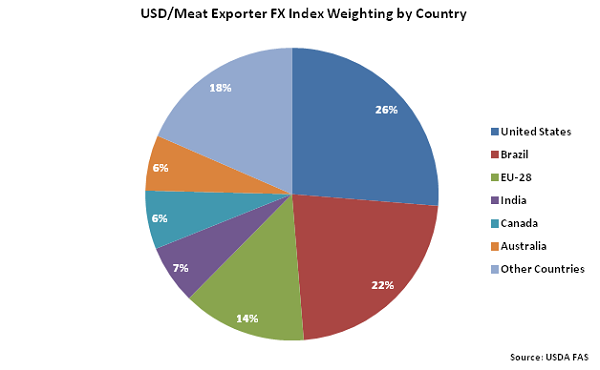 Japan accounts for 14% of the USD/Meat Importer FX Index, followed by Russia at 12%. Mexico, the United States, China, the EU-28, Hong Kong and Saudi Arabia each account for between 5-10% of the index.
Japan accounts for 14% of the USD/Meat Importer FX Index, followed by Russia at 12%. Mexico, the United States, China, the EU-28, Hong Kong and Saudi Arabia each account for between 5-10% of the index.
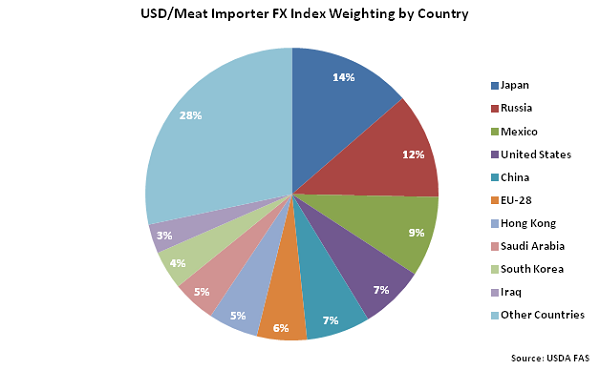 USD/Meat Exporter FX Index:
The USD/Meat Exporter FX Index declined 1.7 points during Jan ’17, finishing at a value of 93.3. The USD/Meat Exporter FX Index remains up 3.9 points throughout the past six months and 61.4 points since the beginning of 2014, despite the most recent decline. A strong USD/Meat Exporter FX Index reduces the competitiveness of U.S. meat relative to other exporting regions (represented in green in the Global Meat Net Trade chart), ultimately resulting in less foreign demand, all other factors being equal. USD appreciation against the Argentine peso and Belarusian ruble has accounted for the majority of the gains since the beginning of 2014.
USD/Meat Exporter FX Index:
The USD/Meat Exporter FX Index declined 1.7 points during Jan ’17, finishing at a value of 93.3. The USD/Meat Exporter FX Index remains up 3.9 points throughout the past six months and 61.4 points since the beginning of 2014, despite the most recent decline. A strong USD/Meat Exporter FX Index reduces the competitiveness of U.S. meat relative to other exporting regions (represented in green in the Global Meat Net Trade chart), ultimately resulting in less foreign demand, all other factors being equal. USD appreciation against the Argentine peso and Belarusian ruble has accounted for the majority of the gains since the beginning of 2014.
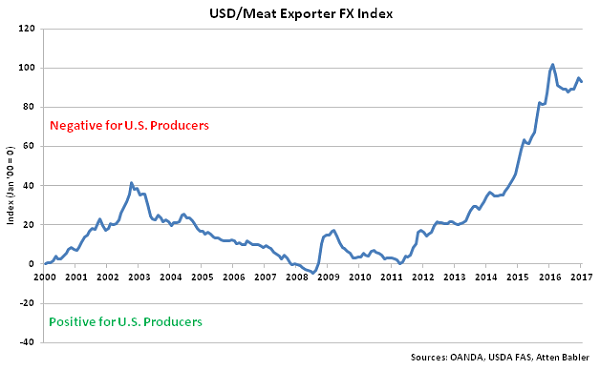 Appreciation against the USD within the USD/Meat Exporter FX Index during Jan ’17 was led by gains by the Brazilian real, followed by gains by the euro and Australian dollar. USD gains were exhibited against the Mexican peso and Turkish lira.
Appreciation against the USD within the USD/Meat Exporter FX Index during Jan ’17 was led by gains by the Brazilian real, followed by gains by the euro and Australian dollar. USD gains were exhibited against the Mexican peso and Turkish lira.
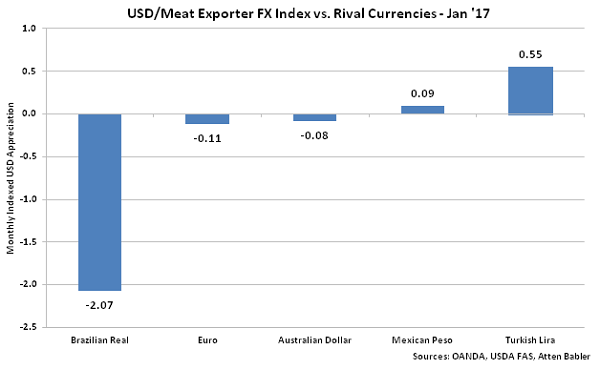 USD/Meat Importer FX Index:
The USD/Meat Importer FX Index increased 0.8 points during Jan ’17, finishing at a record high value of 133.5. The USD/Meat Importer FX Index has increased 7.5 points throughout the past six months and 72.3 points since the beginning of 2014. A strong USD/Meat Importer FX Index results in less purchasing power for major meat importing countries (represented in red in the Global Meat Net Trade chart), making U.S. meat more expensive to import. USD appreciation against the Venezuelan bolivar, Angolan kwanza and Russian ruble has accounted for the majority of the gains since the beginning of 2014.
USD/Meat Importer FX Index:
The USD/Meat Importer FX Index increased 0.8 points during Jan ’17, finishing at a record high value of 133.5. The USD/Meat Importer FX Index has increased 7.5 points throughout the past six months and 72.3 points since the beginning of 2014. A strong USD/Meat Importer FX Index results in less purchasing power for major meat importing countries (represented in red in the Global Meat Net Trade chart), making U.S. meat more expensive to import. USD appreciation against the Venezuelan bolivar, Angolan kwanza and Russian ruble has accounted for the majority of the gains since the beginning of 2014.
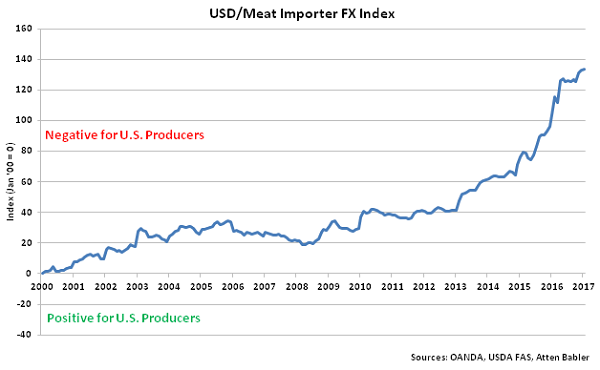 USD appreciation within the USD/Meat Importer FX Index during Jan ’17 was led by gains against the Mexican peso, followed by USD appreciation against the Iranian rial, Congolese franc and Ukrainian hryvnia. USD declines were exhibited against the Russian ruble.
USD appreciation within the USD/Meat Importer FX Index during Jan ’17 was led by gains against the Mexican peso, followed by USD appreciation against the Iranian rial, Congolese franc and Ukrainian hryvnia. USD declines were exhibited against the Russian ruble.
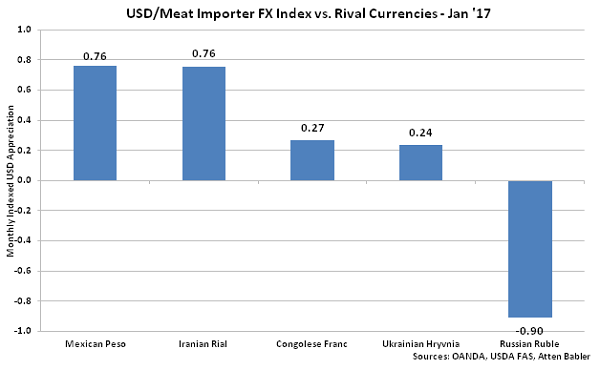 U.S. Meat Export Destinations:
Major destinations for U.S. meat exports are led by Mexico, followed by Japan, China, Canada, and Hong Kong.
U.S. Meat Export Destinations:
Major destinations for U.S. meat exports are led by Mexico, followed by Japan, China, Canada, and Hong Kong.
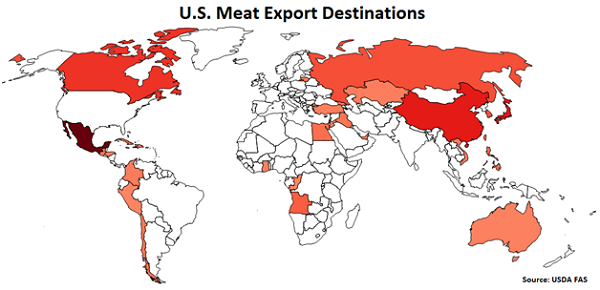 Mexico accounts for over a quarter of the USD/Domestic Meat Importer FX Index, followed by Japan at 11%. China, Canada and Hong Kong each account for between 5-10% of the index.
Mexico accounts for over a quarter of the USD/Domestic Meat Importer FX Index, followed by Japan at 11%. China, Canada and Hong Kong each account for between 5-10% of the index.
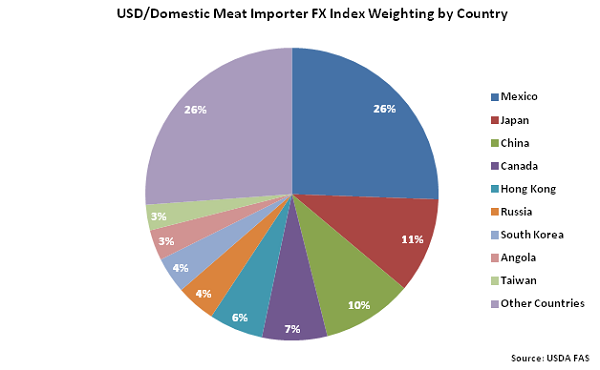 USD/Domestic Meat Importer FX Index:
The USD/Domestic Meat Importer FX Index increased 2.4 points in Jan ’17, finishing at a record high value of 118.9. The USD/Domestic Meat Importer FX Index has increased 17.6 points throughout the past six months and 72.5 points since the beginning of 2014. A strong USD/Domestic Meat Importer FX Index results in less purchasing power for the traditional buyers of U.S. meat (represented in red in the U.S. Meat Export Destinations chart), ultimately resulting in less foreign demand, all other factors being equal. USD appreciation against the Angolan kwanza and Mexican peso has accounted for the majority of the gains since the beginning of 2014.
USD/Domestic Meat Importer FX Index:
The USD/Domestic Meat Importer FX Index increased 2.4 points in Jan ’17, finishing at a record high value of 118.9. The USD/Domestic Meat Importer FX Index has increased 17.6 points throughout the past six months and 72.5 points since the beginning of 2014. A strong USD/Domestic Meat Importer FX Index results in less purchasing power for the traditional buyers of U.S. meat (represented in red in the U.S. Meat Export Destinations chart), ultimately resulting in less foreign demand, all other factors being equal. USD appreciation against the Angolan kwanza and Mexican peso has accounted for the majority of the gains since the beginning of 2014.
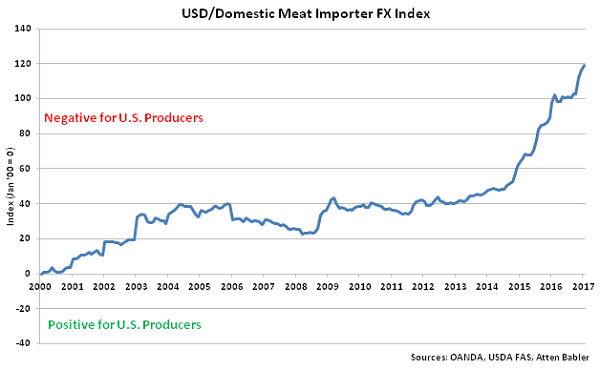 USD appreciation within the USD/Domestic Meat Importer FX Index during Jan ’17 was led by gains against the Mexican peso, followed by USD appreciation against the Turkish lira, Congolese franc and Egyptian pound. USD declines were exhibited against the Russian ruble.
USD appreciation within the USD/Domestic Meat Importer FX Index during Jan ’17 was led by gains against the Mexican peso, followed by USD appreciation against the Turkish lira, Congolese franc and Egyptian pound. USD declines were exhibited against the Russian ruble.
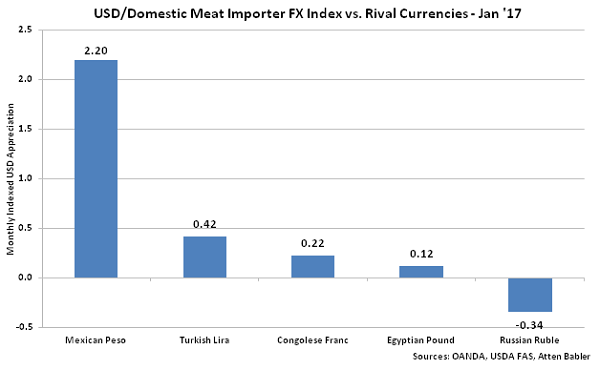
 The United States accounts for over a quarter of the USD/Meat Exporter FX Index, followed by Brazil at 22% and the EU-28 at 14%. India, Canada and Australia each account for between 5-10% of the index.
The United States accounts for over a quarter of the USD/Meat Exporter FX Index, followed by Brazil at 22% and the EU-28 at 14%. India, Canada and Australia each account for between 5-10% of the index.
 Japan accounts for 14% of the USD/Meat Importer FX Index, followed by Russia at 12%. Mexico, the United States, China, the EU-28, Hong Kong and Saudi Arabia each account for between 5-10% of the index.
Japan accounts for 14% of the USD/Meat Importer FX Index, followed by Russia at 12%. Mexico, the United States, China, the EU-28, Hong Kong and Saudi Arabia each account for between 5-10% of the index.
 USD/Meat Exporter FX Index:
The USD/Meat Exporter FX Index declined 1.7 points during Jan ’17, finishing at a value of 93.3. The USD/Meat Exporter FX Index remains up 3.9 points throughout the past six months and 61.4 points since the beginning of 2014, despite the most recent decline. A strong USD/Meat Exporter FX Index reduces the competitiveness of U.S. meat relative to other exporting regions (represented in green in the Global Meat Net Trade chart), ultimately resulting in less foreign demand, all other factors being equal. USD appreciation against the Argentine peso and Belarusian ruble has accounted for the majority of the gains since the beginning of 2014.
USD/Meat Exporter FX Index:
The USD/Meat Exporter FX Index declined 1.7 points during Jan ’17, finishing at a value of 93.3. The USD/Meat Exporter FX Index remains up 3.9 points throughout the past six months and 61.4 points since the beginning of 2014, despite the most recent decline. A strong USD/Meat Exporter FX Index reduces the competitiveness of U.S. meat relative to other exporting regions (represented in green in the Global Meat Net Trade chart), ultimately resulting in less foreign demand, all other factors being equal. USD appreciation against the Argentine peso and Belarusian ruble has accounted for the majority of the gains since the beginning of 2014.
 Appreciation against the USD within the USD/Meat Exporter FX Index during Jan ’17 was led by gains by the Brazilian real, followed by gains by the euro and Australian dollar. USD gains were exhibited against the Mexican peso and Turkish lira.
Appreciation against the USD within the USD/Meat Exporter FX Index during Jan ’17 was led by gains by the Brazilian real, followed by gains by the euro and Australian dollar. USD gains were exhibited against the Mexican peso and Turkish lira.
 USD/Meat Importer FX Index:
The USD/Meat Importer FX Index increased 0.8 points during Jan ’17, finishing at a record high value of 133.5. The USD/Meat Importer FX Index has increased 7.5 points throughout the past six months and 72.3 points since the beginning of 2014. A strong USD/Meat Importer FX Index results in less purchasing power for major meat importing countries (represented in red in the Global Meat Net Trade chart), making U.S. meat more expensive to import. USD appreciation against the Venezuelan bolivar, Angolan kwanza and Russian ruble has accounted for the majority of the gains since the beginning of 2014.
USD/Meat Importer FX Index:
The USD/Meat Importer FX Index increased 0.8 points during Jan ’17, finishing at a record high value of 133.5. The USD/Meat Importer FX Index has increased 7.5 points throughout the past six months and 72.3 points since the beginning of 2014. A strong USD/Meat Importer FX Index results in less purchasing power for major meat importing countries (represented in red in the Global Meat Net Trade chart), making U.S. meat more expensive to import. USD appreciation against the Venezuelan bolivar, Angolan kwanza and Russian ruble has accounted for the majority of the gains since the beginning of 2014.
 USD appreciation within the USD/Meat Importer FX Index during Jan ’17 was led by gains against the Mexican peso, followed by USD appreciation against the Iranian rial, Congolese franc and Ukrainian hryvnia. USD declines were exhibited against the Russian ruble.
USD appreciation within the USD/Meat Importer FX Index during Jan ’17 was led by gains against the Mexican peso, followed by USD appreciation against the Iranian rial, Congolese franc and Ukrainian hryvnia. USD declines were exhibited against the Russian ruble.
 U.S. Meat Export Destinations:
Major destinations for U.S. meat exports are led by Mexico, followed by Japan, China, Canada, and Hong Kong.
U.S. Meat Export Destinations:
Major destinations for U.S. meat exports are led by Mexico, followed by Japan, China, Canada, and Hong Kong.
 Mexico accounts for over a quarter of the USD/Domestic Meat Importer FX Index, followed by Japan at 11%. China, Canada and Hong Kong each account for between 5-10% of the index.
Mexico accounts for over a quarter of the USD/Domestic Meat Importer FX Index, followed by Japan at 11%. China, Canada and Hong Kong each account for between 5-10% of the index.
 USD/Domestic Meat Importer FX Index:
The USD/Domestic Meat Importer FX Index increased 2.4 points in Jan ’17, finishing at a record high value of 118.9. The USD/Domestic Meat Importer FX Index has increased 17.6 points throughout the past six months and 72.5 points since the beginning of 2014. A strong USD/Domestic Meat Importer FX Index results in less purchasing power for the traditional buyers of U.S. meat (represented in red in the U.S. Meat Export Destinations chart), ultimately resulting in less foreign demand, all other factors being equal. USD appreciation against the Angolan kwanza and Mexican peso has accounted for the majority of the gains since the beginning of 2014.
USD/Domestic Meat Importer FX Index:
The USD/Domestic Meat Importer FX Index increased 2.4 points in Jan ’17, finishing at a record high value of 118.9. The USD/Domestic Meat Importer FX Index has increased 17.6 points throughout the past six months and 72.5 points since the beginning of 2014. A strong USD/Domestic Meat Importer FX Index results in less purchasing power for the traditional buyers of U.S. meat (represented in red in the U.S. Meat Export Destinations chart), ultimately resulting in less foreign demand, all other factors being equal. USD appreciation against the Angolan kwanza and Mexican peso has accounted for the majority of the gains since the beginning of 2014.
 USD appreciation within the USD/Domestic Meat Importer FX Index during Jan ’17 was led by gains against the Mexican peso, followed by USD appreciation against the Turkish lira, Congolese franc and Egyptian pound. USD declines were exhibited against the Russian ruble.
USD appreciation within the USD/Domestic Meat Importer FX Index during Jan ’17 was led by gains against the Mexican peso, followed by USD appreciation against the Turkish lira, Congolese franc and Egyptian pound. USD declines were exhibited against the Russian ruble.
